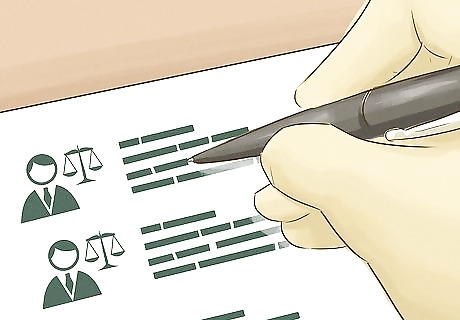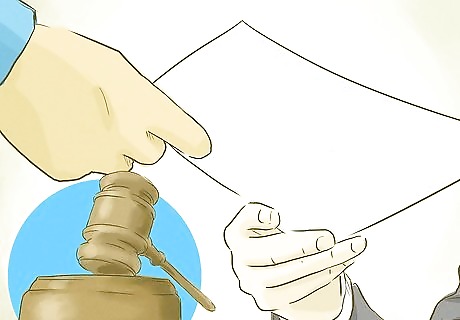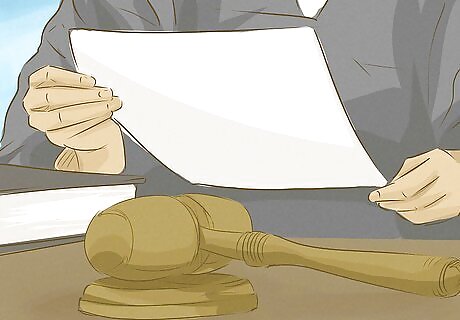
views
Considering An Attorney

Search for a good family law attorney. In a divorce, you and your spouse will be a part of a legal proceeding to end your marriage relationship. Family law attorneys deal with divorce cases regularly, so if you are going to hire an attorney, you should hire a reputable one that has handled similar cases in the past. To choose a good family law attorney, consider the following: Find an attorney that can practice law in the state, and in the courts, you need them to. For example, if you are filing for divorce in South Carolina, find an attorney that is licensed to practice law in South Carolina. Ask your friends and family for attorney recommendations. Ask them about any experiences they may have had, and ask for the absolute truth. Search the internet for reputable divorce lawyers. Consider using your state bar's website; public websites like LawHelp.org; and online directories like Lawyers.com, LawInfo.com, and FindLaw.com. Check online reviews, which are often written by past clients who have either had positive or negative experiences. These online reviews can be very helpful and honest, so do some internet searches to try and learn about lawyers you are considering.

Make a decision. Once you have researched family law attorneys and have some ideas, narrow down your list and contact your top choices. Ask your top choices for a consultation so you have an opportunity to explain the situation you are in and the services you need. A consultation will also give you an opportunity to determine how you think you would work with the attorney. After you have met with attorneys and researched their background and expertise, you should make a final decision on who you will hire. Choose an attorney that makes you feel comfortable, that seems to know how to handle your case, and who feels confident in their ability to represent you in an effective manner.

Avoid bad attorneys. While there are many attorneys in the world, not all of them are particularly good. Avoid hiring an attorney who: Solicits you as opposed to the other way around; Pressures you into making a hiring decision quickly; Refuses to tell you about their background and credentials; and Suggests that they will handle the case in an unethical manner.

Look into low-income options. Many states offer legal services to low-income individuals through legal self-help programs, legal aid organizations, legal clinics, and through sliding-scale fee arrangements. If you are having trouble finding a lawyer you can afford, try one of these options. A self-help program allows you, the client, to ask questions of attorneys and paralegals regarding your divorce. This is a great option if you only have a couple of quick questions that you need answers to. You will often call or talk to an attorney online and they will try and assist you. To find these programs, contact your local court or bar association. A legal aid organization is a nonprofit offering legal services to low-income individuals who qualify. If you are eligible, an attorney will help you through the divorce process free of charge. This is a great resource if you need a full-time attorney as opposed to needing just a couple of questions answered. Legal clinics are programs set up by local law schools to help train the lawyers of tomorrow. Here, law students will help a number of individuals under the supervision of actual lawyers. To find out if your local law school has a clinic that can help you with your divorce, call the law school or look at their website. For more information, look at this wikiHow article on hiring a lawyer when you have a low income: Hire a Lawyer When You Have Low Income.

Consider representing yourself. If you do not feel comfortable hiring an attorney, do not have the funds available to do so, or if you and your spouse agree on the amendments you are making, you may want to consider representing yourself throughout the amendment process. While this is certainly possible, if you have the means to hire an attorney, you should strongly consider doing so. An attorney has a unique set of skills that can help you navigate the judicial system and can help you get want you want out of the amendment process. If you end up representing yourself, you can always ask an attorney to review certain documents or give you limited advice.
Preparing Your Divorce Petition Amendment

Determine if you can amend your divorce petition. In general, you will be able to amend your original petition freely so long as your spouse has not responded to the original complaint. Also, if this is your first amended complaint, as opposed to your second or third, a judge will usually allow you to freely make the amendment. However, if your spouse has responded to your original complaint, or if you have made previous amendments to your petition, you may have to persuade a judge to allow you to make the amendments during a court hearing. For example, under Texas law, you can freely amend your complaint any time prior to seven days before the final hearing in your case, so long as the amendment does not cause a surprise for your spouse. If you want to amend your complaint within the seven day window, or if your spouse claims surprise, you will need the court's permission to file an amendment, which usually involves a hearing. Under California law, you can freely amend your complaint once without the court's permission so long as your spouse has not responded to the original.

Contact your spouse. Once you understand the general amendment laws in your state, you should contact your spouse to discuss the possible amendment. Discussing the amendment before completing the form and filing it will hopefully lead to a less adversarial amendment process (e.g., it may negate your spouse's ability to claim surprise). Furthermore, if your spouse does not object to the amendment, you can include that information in the amended petition, which will increase the chances of a judge signing off on it. However, if your spouse will not agree to the amendment, you may have to go to a court hearing and convince the judge to sign off on the amendment.

Request an amendment form. At this point, you are ready to retrieve an amended complaint form to fill out. Most courts will put their forms online for everyone to access. Check your local court's website to see if the required form is available online. When you do so, you will want the form titled "divorce petition," "dissolution petition," or "divorce petition amendment." If your local court does not allow for online access, you can always go to the courthouse in person and ask them for the correct form. Someone at the courthouse will be able to point you in the right direction.

Complete the amendment form. After you obtain the correct form, you will need to fill it out accurately and completely. In general, an amendment form will ask for all the same information your original complaint contained, but will ask you to make the necessary changes to the petition. You will need to include the specific reasons why and how you are changing the original divorce petition. You might need to amend your original petition in order to include topics you forgot to include the first time, such as spousal support, child custody, or a change of address or phone number. For example, if your original divorce petition claimed that only the household furniture was community property, and now you want to amend the petition to include a television as community property, you will simply list all of these things in your amendment. In another example, if you forgot to include a demand for spousal support in your original petition, you may want to amend the petition to include this demand.
Filing Your Amended Divorce Petition

File your amendment with the clerk of courts. After completing the required amendment form, take it to the local courthouse where you filed your original complaint. You will then file your amendment with the clerk of courts. The clerk of courts will file your original amendment form and will give you a number of copies.

Pay any required fee. When you file your amended divorce petition, you may have to pay a filing fee. Every state will have a different policy on fees, so be sure you are prepared to pay the fee in your community. If there is a fee and you cannot afford it, ask the clerk of courts about obtaining a fee waiver. For example, in California, there is no filing fee for filing amended petitions.

Serve your spouse with the amended documents. Once your amendment is filed, you will need to hire a professional third party to serve the amendment on your spouse. You are not allowed to serve your spouse yourself. For instructions on successfully serving another party, see this wikiHow article: https://www.wikihow.com/Serve-Court-Papers.

File your proof of service. Once your spouse has been served, ask the process server to complete and return a "proof of service" form. File that document with the clerk of courts where you filed your amended complaint. For an extra fee, some process servers will file the proof of service form for you.
Attending Your Amendment Hearing

Request a hearing date when you file your amendment. If your state does not allow you to freely amend divorce petitions and you have to go through a hearing process to get your amendment approved, you will request a hearing date when you file your amended petition with the clerk of courts. This hearing will only resolve the amendment issue and it will not resolve the entire divorce. After you have scheduled a hearing, you will serve that information on your spouse along with the amended divorce petition.

Attend your hearing. On the day of your hearing, arrive at your local courthouse early and dress appropriately. Once in the courtroom, wait for your case and then step in front of the judge. In all likelihood, your spouse and/or their representative will be in attendance as well. You and your spouse will both have an opportunity to tell the judge why the amendment should be allowed (or disallowed). In general, you will want to tell the judge that the original petition has a mistake that, if not corrected, would materially affect the potential outcome of the divorce. You will need to tell the judge why you made the mistake and how you plan on fixing it. Also, tell the judge why the amendment will not put your spouse at a disadvantage. Your spouse may agree that the amendment should be allowed. If this happens, the judge is likely to allow it because both parties are in agreement. If your spouse is contesting the amendment, they may try and tell the court that the amendment is a surprise and will hurt the case they have built to this point. Also, your spouse may argue that the information you are looking to include was readily available to you before you filed your original petition, and therefore it should have been included there and you should not have the opportunity to go back and try again.

Wait for the judge's decision. After you and your spouse have had an opportunity to plead your case, the judge will make their decision on the issue. Unless you are doing something egregious, a court will usually allow the amendment. If the judge agrees with your position, you will be permitted to make the amendment.


















Comments
0 comment